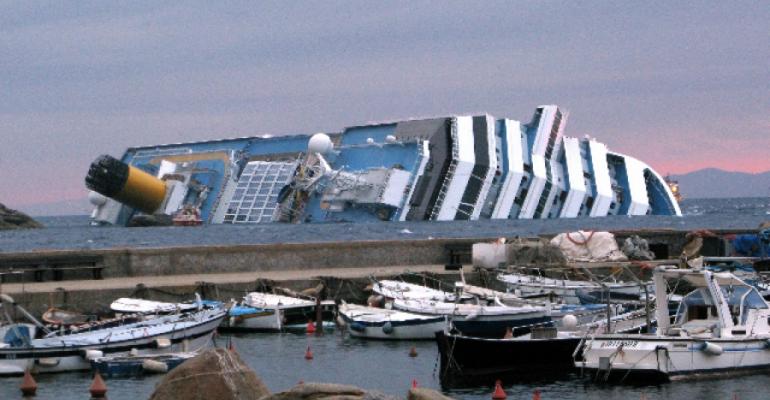Whilst the search and rescue operation continues for 29 missing Costa Concordia passengers and crew, the Italian Admiralty and Coastguard, vessel insurers and Costa Crociere are meeting today to decide what happens next to the vessel that grounded Friday at Italy’s Giglio.
This morning in nearby Port Santo Stefano, the salvage experts SMIT outlined their role in preparing for the removal of fuel from the vessel.
‘The top priority is the search and rescue operation which is still ongoing and which we are not involved in,’ said Martijn Schuttevaer, director investor relations & corporate communications, Royal Boskalis Westminster, the parent company of SMIT.
The Dutch salvor has been asked to prepare Costa Concordia for the removal of fuel, including 2,400 tons of heavy fuel oil, 200 tons of diesel oil and litres of other lubricants located in different areas of the partly submerged ship.
SMIT spent the last two days bringing together a team of salvage experts, divers and equipment to the locality, a small island off the Tuscan coast. ‘We are now waiting to get the go ahead,’ said Kees van Essen, operations manager at SMIT, who confirmed the work is likely to take two to four weeks.
What happens after that is still to be determined, Schuttevaer said, adding that the insurers will have to inspect the vessel in the first instance.
‘Before salvage operations begin it is necessary to remove any harmful liquids from the vessel using hot-tapping technology,’ he continued. This is common practice in salvage and SMIT has many years of experience using the technique for removing pollutants from the tanks of listed and sunken vessels.
This requires drilling holes through the hull plating into the fuel tanks before a valve and cam lock hose fitting is installed on the tank. A hot-tap device is then fitted enabling the salvor to drill through the plating without allowing the tank's contents to escape. A suction hose is then attached allowing the transfer of the liquid to the recovery vessel.
A barge will be used for the intermediate recovery and the fuel will be transferred to a larger offloading vessel nearby, the SMIT team outlined. The company has successfully recovered oil from sunken tankers, listing container ships and other cargo vessels in various locations around the world. Van Essen called the whole process a ‘standard and proven method of removing oil without spillage from a stricken vessel.’
Yesterday floating booms were positioned around the vessel to contain any fuel spill but the SMIT executive confirmed there had been no leakage of fuel from Costa Concordia in the past two days. But Schuttevaer said the sooner the fuel removal operation can start, the better: ‘There is always an environmental risk to these operations,’ he noted.
Reports on Monday suggested the forward part of the vessel not lying on rocks had moved but SMIT described this as ‘a slight up and down movement rather than a shift in the vessel.’ Whilst SMIT has not been able to fully survey the ship, according to van Essen monitoring instruments have been fitted to the hull so its movement can be closely monitored. He said any danger of the ship sliding down into deeper waters is ‘minimal’.
As for the bigger and lengthier task of salvaging the ship, it all depends on what the P&I Club, hull and machinery insurers and owners decide, according to Schuttevaer, who confirmed SMIT has not been contracted to undertake this job, although ‘there is a correlation between the removal of the fuel and the ultimate removal of the vessel.’
The Italian authorities have insisted the ship needs to be eventually removed from its current resting place. Whether Costa Concordia could be salvaged in one piece or if it would be necessary to cut the vessel in situ to remove it, van Essen noted there have not been too many accidents like this with cruiseships so it’s difficult to say without a full inspection ‘but salvage companies always try to remove a vessel as one piece.’
He recalled the procedure with Herald of Free Enterprise, a car and passenger ferry owned by Townsend Thoresen which capsized in 1987 off Zeebrugge, killing 193 passengers and crew.
Dutch company Smit-Tak Towage and Salvage, part of Smit International, refloated the vessel, enabling the removal of the remaining bodies trapped underwater. The ship was towed to a shipyard and subsequently sold for scrap.
Copyright © 2024. All rights reserved. Seatrade, a trading name of Informa Markets (UK) Limited. Add Seatrade Cruise News to your Google News feed.


